Itchy Scalp – Pictures, Causes and Treatment
1. Unwashed Hair
When the hair (especially oily hair) is not washed frequently enough, skin cells may build up on the scalp and cause itching and dandruff. Prevention is therefore by simply maintaining good hygiene and washing the scalp hair at least once a week.
2. Dry Scalp Skin
Dry scalp skin lacking the protective oil layer, is vulnerable to infections, and easily gets irritated. From the top of the head or hairline skin cells in the form of white dust (dry dandruff) may shed. Common causes of dry flaky scalp are:
- Frequent hair washing with hot water and aggressive shampoos
- Holding hair dryer close to the head
- Cold windy weather in combination with dry air from indoor heating
Prevention is by using “shampoos for dry hair”.
3. Stress
Stress is a common cause of itch. Scalp, face, and neck are often affected.
4. Neurogenic Excoriation
Scratching from psychical reasons may cause itchy scalp scratches (neurogenic excoriations).
5. Dandruff, Caused by Fungi or Seborrheic Dermatitis
Dandruff are whitish, greasy, thin skin flakes, few millimeters in size, appearing in the hair and falling on shoulders. The scalp skin is itchy and may be reddened. The common cause is fungus Malassezia furfur (formerly known as Pityrosporum ovale) that normally lives on the scalp, but may overgrow on the greasy scalp, irritating it and causing scaling.
Dandruff may be related to seborrheic dermatitis, where irritated oil glands produce excessive amount of oil, resulting in an inflamed reddened scalp. Besides the scalp, the eyebrows or eyelids, skin on the sides of the nose, behind the ears, and in the groin may be affected.
Dandruff usually does not appear before puberty, and it is more often in males, perhaps due to stimulation of oil glands by male sexual hormones. Diet poor in B vitamins, zinc, and essential fatty acids may also cause dandruff. Cold weather and indoor heating during winter may aggravate scalp scaling.
Treatment of Dandruff
Treatment of dandruff depends on the cause.
Mild dandruff can be controlled by regular hair washing with gentle shampoos to avoid greasiness. Hot water should be avoided and hair rinsed well after washing to prevent scalp irritating.
When regular shampoos do not help, over-the-counter medical shampoos can be tried (1):
- In malassezia fungal infection, shampoos containing zinc pyrithione, selenium sulfide or ketoconazole are usually effective. Tea tree oil, a component of several ‘natural’ shampoos has antiseptic and anti-fungal properties
- In seborrheic dermatitis, shampoos containing coal tar or salicylic acid may help
Several weeks of hair washing every day, and keeping shampoo on the hair for at least 5 minutes every time may be needed to get rid of dandruff.
Prevention of Dandruff
Alcohol based hair styling products should be avoided, since they dry up the scalp. Regular exposure to sun (but not sunbathing) may help in treating fungal infection. Learning to cope with stress and avoiding saturated fatty acids and trans-fatty oils may reduce oil glands secretion (2).
Diet in Dandruff
Nutrients to avoid:
- Simple sugars like glucose, fructose, since they lower vitamin B6 level
- Saturated fatty acids in meat and milk, since they increase oil gland secretion
Nutrients to consider (good for healthy scalp skin):
- Omega-3 and omega-6 unsaturated fatty acids
- Vitamins B (cabbage), A (carrots), and E, but not as supplements, if blood levels are normal
6. Cradle Cap in Infants
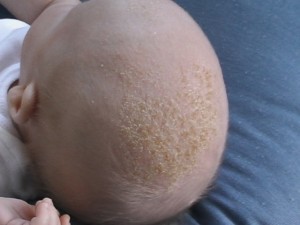 Picture 1. Cradle cap
Picture 1. Cradle cap
(source: Wikimedia)
In infants, especially in newborns, crusting and scaling may appear on the scalp. Condition, called ‘cradle cap’, is caused by overactive oil glands, and usually disappears by the first year of age. Treatment is by applying mineral oil or baby oil after shampooing, and rubbing the scales off with a soft brush. Cradle cap is harmless and non-contagious, but may itch.
7. Scalp Sunburn
Scalp sunburn can burn or itch. Affected skin is red, tender and usually start to shed after few days. To ease burning and itching, first get out of the sun, and wear light protective hat when you can not avoid the sun. Apple cider vinegar, or after sun lotions applied on the scalp may ease burning. Cool shower may provide temporary relief. Painkillers as aspirin or ibuprofen help ease the pain. Lotions with anesthetics should be avoided since they may cause allergic reaction. In strong sunburn, oral corticosteroids may be needed to reduce swelling.
8. Acne
Acne on the scalp usually appear on the hair border. Acne vulgaris are treated with common anti-acne ointments.
9. Folliculitis
Folliculitis caused by bacterium Staphylococcus aureus causes red bumps with occasional pus-filled centers on the scalp. Common cause is auto-infection from other parts of infected skin. Treatment, if necessary is by over-the-counter antibacterial shampoos, or in severe cases with oral antibiotics by mouth. Several other types of folliculitis may affect the scalp.
10. Scalp Ringworm (Tinea Capitis)
Tinea capitis is fungal infection of the scalp mostly seen in pre-school children (3-7 years of age), but can also occur in adults. It is caused by group of fungi that normally live on the skin (dermatophytes) but may overgrow in certain circumstances. Tinea capitis may present as itchy, scaling area of hair loss, black dots (parts of broken hair in the scalp skin), yellow crusts (favus) or rough, thickened inflamed area (kerion). Lymph nodes on the sides of the back of the neck may be enlarged.
Tinea capitis is contagious, so other family members should be examined in suspected cases.
Therapy is by prescribed anti-fungals by mouth such as griseofulvin or terbinafine for 4-6 weeks (3).
Scalp Ringworm Pictures
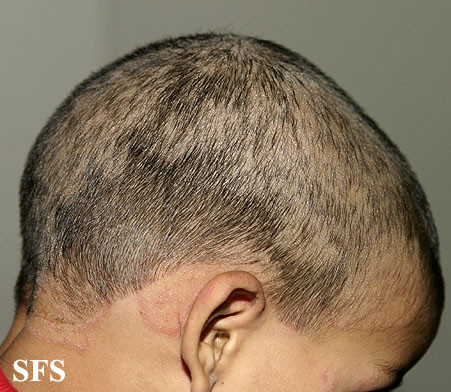 | Picture 2. Scalp ringworm (Tinea capitis)A mild but widespread infection by Tinea capitis. Inflamed areas are seen on the front, behind the ear and on the back of the neck. |
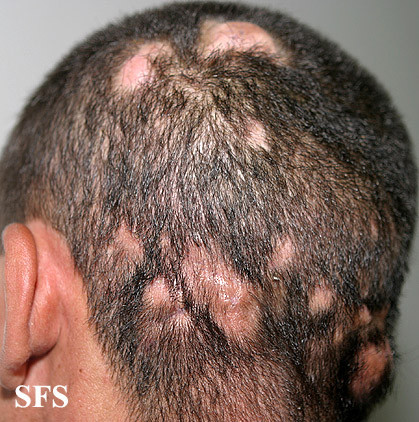 | Picture 3. Scalp ringworm (Tinea capitis) Multiple areas of hair loss; bumps are from inflammation within the skin |
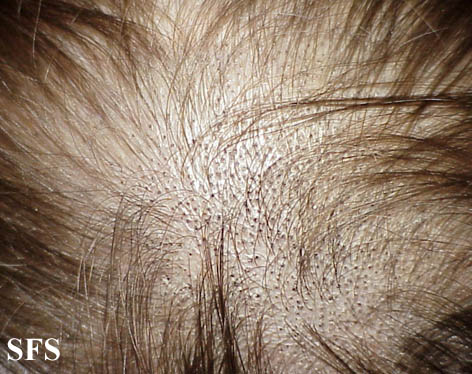 | Picture 4. Scalp ringworm (Tinea capitis) Black dots are from broken hair |
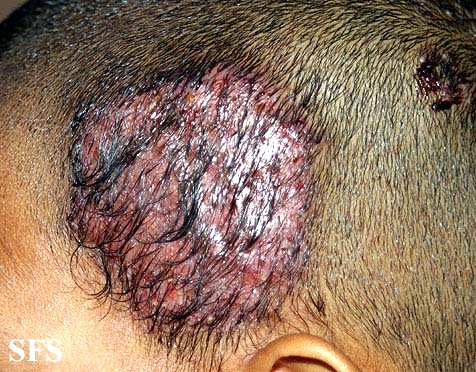 | Picture 5. Scalp ringworm (Tinea capitis)Rough, thick scalp inflammation, known as a kerion (a lump can be felt on the scalp). |
Source of images 2-5: Samuel Freire da Silva, M.D., atlasdermatologico
11. Tinea Amiantacea
Tinea amiantacea (Amia is a fish species with silvery skin) is another (rare) type of fungi that causes itchy scalp. Silvery skin scales are attached on the base of the hair thus gluing hair in tufts.
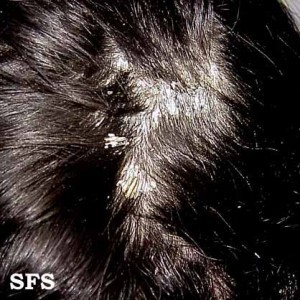
12. Head Lice (Pediculosis capitis)
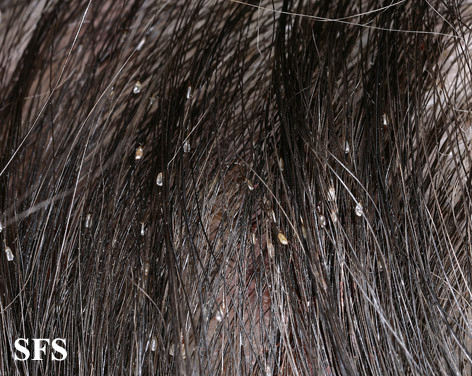 Picture 6. Head lice – Pediculosis capitis (source: Samuel Freire da Silva, M.D., atlasdermatologico)
Picture 6. Head lice – Pediculosis capitis (source: Samuel Freire da Silva, M.D., atlasdermatologico)
Head lice may cause intense itch of scalp, neck, and shoulders due to allergic reaction to lice saliva. Adult louse is white or grey, about 2 mm long, and may be found on the hair by inspection and using a special lice-comb. Lice eggs (nits), are white, about 0.5 mm in size, and are firmly attached to the hair base.
Anyone with the hair can get head lice, but children are mostly affected.
Treatment of Head Lice
Over-the-counter anti-lice powders, lotions, or shampoos, containing pyrethrins or permethrine should be tried first. Head lice are highly contagious, so close head-to-head contact and sharing caps, headphones, and the like with infected persons should be avoided. Bed linen, clothes, and all items that were likely in contact with infected person should be washed, or if this is not possible, sealed for two weeks, what will kill the lice and eggs.
If over-the-counter products do not help, prescription lotions containing malathion or lindane should be used. Detailed instructions from CDC about treating head lice.
13. Chickenpox and Shingles (Herpes zoster)
Chickenpox in children may appear as itchy, red, crusting rash all over the skin, including the scalp.
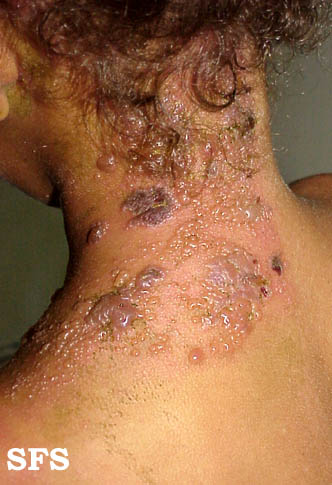 Picture 7. Herpes zoster – shingles affecting the shoulder, neck and scalp(source: Samuel Freire da Silva, M.D., atlasdermatologico)
Picture 7. Herpes zoster – shingles affecting the shoulder, neck and scalp(source: Samuel Freire da Silva, M.D., atlasdermatologico)
Shingles represent reactivation of Herps zoster virus acquired during chickenpox, that remained dormant in roots of spinal or cranial nerves. Crusty, itchy or painful rash is typically confined to a course of affected nerve, usually only on one side of the head (or neck, arms, trunk or legs).
Chickenpox and shingles heal on their own in few weeks. Antiviral drugs and steroids by mouth speed up healing, though (5). Topical capsaicin or pain killers can be used to relieve pain.
14.Scalp Psoriasis
Scalp psoriasis may occur in isolation or as a part of generally affected skin. Condition may differ a lot in severity – from tiny scales to large thick yellowish patches on the reddened scalp skin.
Treatment of Scalp Psoriasis (6)
- Shampoos against dandruff
- Coconut oil ointment, containing coal tar, salicylic acid, and sulphur
- Phototherapy with ultraviolet (UV-B) light
Treatment usually helps in several weeks, but it should be regular, since scalp psoriasis tend to reoccur.
15. Epidermal or Sebaceous Cyst
Epidermal cyst appears as a dome shaped, firm bump, o.5 – 2 cm in size, appearing on the scalp (or neck, upper trunk, armpits, or genitals) that may itch. It represent enlarged, oil-filled hair follicle or oil gland due to blockage of excretion. It may result from an injury, acne, or oil gland defect. Treatment options are: injection of steroids in the cyst, cyst drainage or complete surgical removal.
16. Contact Dermatitis
Shampoos or hair styling products can cause contact dermatitis of the scalp. Affected skin is itchy, reddish with papules or vesicles.
17. Allergic Dermatitis
Hair dyes containing PPD or other substances may cause hair dye allergy. Skin of the scalp (and often face and neck) suddenly becomes itchy, red and swollen. Reaction may last for several hours and then resolves on its own without consequences. Antihistamines or corticosteroids by mouth may speed up resolving the symptoms.
18. Lichen planopilaris
Lichen planopilaris is a type of Lichen planus (Latin lichen =plant growing on rocks and tree trunks; planus = flat), a skin inflammation of unknown origin, that (rarely) affects the scalp. It causes permanent scaring and partial hair loss. Treatment with steroids as ointment or by mouth may relieve itching (4).
Picture of Lichen Planus on the Scalp
Related Articles:
- Itchy Face
- Itchy Neck Rash
- Itchy Skin Causes
- Itchy Rash
- Itch (Pruritus) – Diagnosis and Treatment




